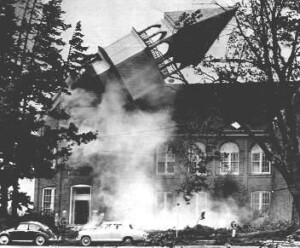Columbus Day Storm: “Worst Disaster Ever”: October 12, 1962

Al Jones, 1962-10-12,
Pictured is the falling bell tower of Campbell Hall at OCE on October 12, 1962, during the Columbus Day Storm. OCE (Oregon College of Education) is now named WOSC (Western Oregon State College)., Salem Public Library MJON0220
Any Salem resident who lived through the Columbus Day Storm will never for-get it. Although it is generally believed to have been a hurricane, the Columbus Day Storm was actually an “extra tropical cyclone,” a weather pattern formed when a cool air mass meets up with a warm one. In addition, the Columbus Day Storm traveled very fast: nearly 1,800 miles in less than one-and-a-half days, much faster than a hurricane. At its peak, between 4 p.m. and 7 p.m. that Friday, it brought gusts of 90 m.p.h. and sustained winds of over 70 m.p.h., and the total damages to Salem, at $4 million, were higher than for any disaster the City had yet seen. One in every three homes in Salem was damaged by the Columbus Day Storm.
The storm came with little warning and hit hard. It crossed the Oregon-California border on Friday, October 12, at noon, moving north at 48 m.p.h., reaching Salem at mid-afternoon. The ferocity of the winds as they roared through Salem shocked residents. In downtown, stunned pedestrians screamed as they were hit by glass from shattering windows, and dodged flying debris of all kinds. Shoppers trying desperately to get home were knocked to the ground by the wind. A brick wall fell on three City employees standing on the sidewalk. Cars were blown onto sidewalks and yards. The large sign on the roof of the Elsinore Theater was battered and crumpled by the wind. The Marion Motor Hotel lost part of a wall on the Commercial Street side, and part of a wall at the Capitol Press Building fell onto two cars; rain then poured into the building. The steeple was torn from the Christ Lutheran Church at 18th and State Streets and dropped onto the sidewalk. St. Paul’s Episcopal Church on Liberty Street also lost its steeple, its point spearing the ground like a javelin. Trees were blown over and uprooted.
At McNary Field, hangars were damaged, as were twelve planes, some of which were overturned. Witnesses said winds were so strong that pieces of the concrete foundation of one hangar were actually lifted from the ground. Parks in the City were all hard hit, in particular Willson Park, which lost so many trees that it would take a State crew one month, working every day, to clean it up. A spruce toppled the three-and-a-quarter-ton “Circuit Rider” statue, splitting it at the seams. Court Street was completely blocked by fallen trees, which had damaged a dozen cars on the street. Two teenagers were killed when the car they were driving was hit by a tree. On the River, small boats were torn from their moorings.
Power was knocked out all over the State, Salem being no exception. Thou-sands lost their electricity, and a Greyhound bus driver was quoted as saying he had seen no lights in the Willamette Valley on a trip between Eugene and Port-land. Some City residents went more than a week without electricity and, in rural areas, up to three weeks. Local repair crews were augmented by crews from Spokane, Washington, and stores reported runs on candles, camp stoves, and white gas. Seven thousand Salem residents lost their phone service, and Northwest Natural Gas reported some broken gas lines. Radio and television towers were knocked over. Lack of water became a problem in hilly areas of the city – including Fairmount Hill, Candalaria, and West Salem, when loss of electricity shut down the pumps.
In the farming areas surrounding Salem, agricultural damage was heavy. Walnut and filbert crops were damaged when the nuts were blown down early and trees were uprooted and split. Crops of cauliflower, broccoli, sweet and field corn sustained heavy damages.
A street crew of 25 men began clean up operations Friday night while the storm still raged, concentrating on creating a single lane through tree-blocked streets. The National Guard was called out to prevent looting of businesses with blown-out windows and holes in their buildings, and the Red Cross began assisting people in need of food and shelter. Governor Mark Hatfield declared the entire State an emergency disaster area, requesting $2.7 million in Federal aid.
On Saturday, October 13, he declared, “Oregon is on the way back. People are exhibiting their pioneer spirit in remarkable fashion.”
Somewhat ironically, the day after the storm was beautiful and warm, a perfect day on which to begin the giant task of cleaning up after such a storm.
Compiled and written by Kathleen Carlson Clements
Bibliography:
Taylor, George and Raymond R. Hatton. The Oregon Weather Book: A State of Extremes. Corvallis: Oregon State University, 1999.
Statesman-Journal, October 11, 1987
Oregon Statesman, October 13-16, 1962
This article originally appeared on the original Salem Online History site and has not been updated since 2006.







Leave A Comment